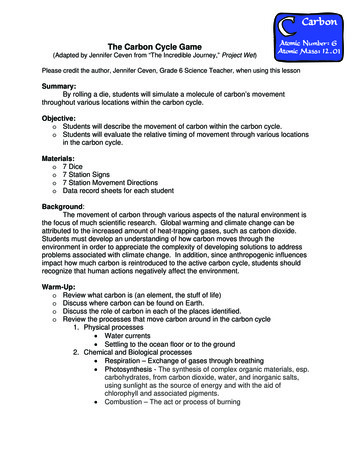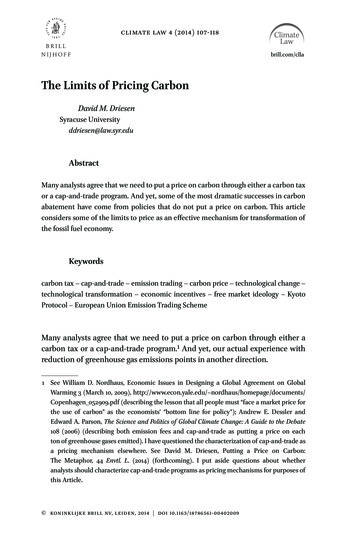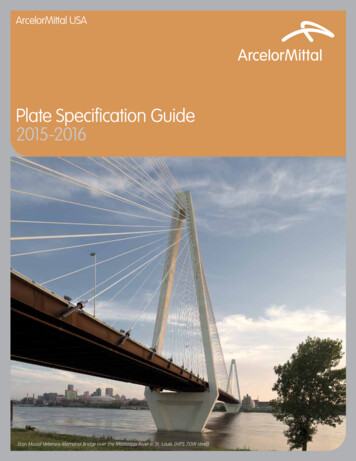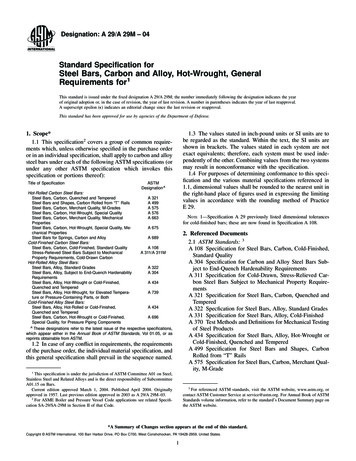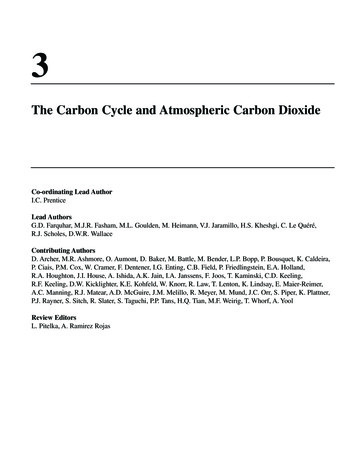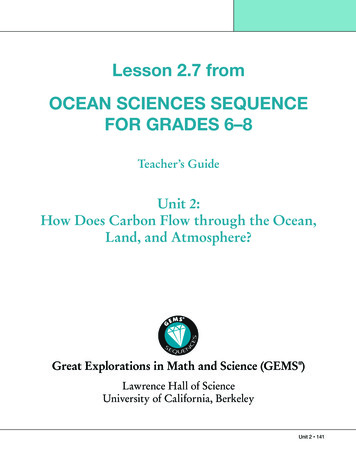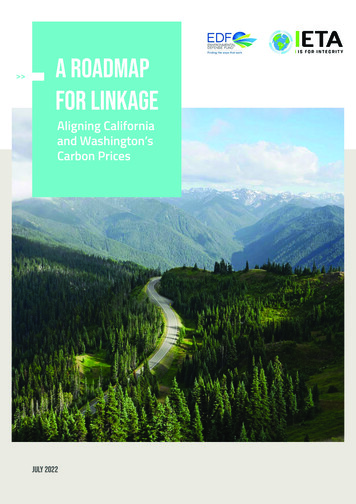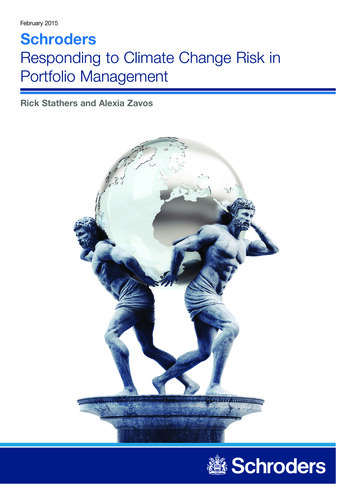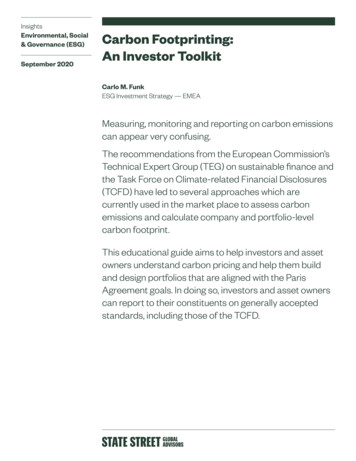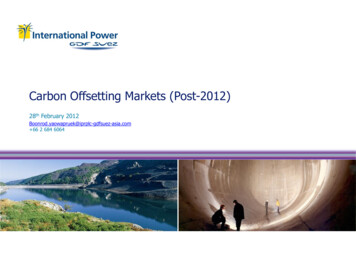
Transcription
Carbon Offsetting Markets (Post-2012)28th February 2012Boonrod.yaowapruek@iprplc-gdfsuez-asia.com 66 2 684 6064
DisclaimerThe release, publication or distribution of the materials to which this gatepost gives access in certain jurisdictions maybe restricted by law and therefore persons in any such jurisdictions into which this announcement is released,published or distributed should inform themselves about, and observe, such restrictions. Any failure to comply with therestrictions may constitute a violation of the laws of any such jurisdiction.These presentation reflects the IPR CDM team’s beliefs and expectations and involve risk and uncertainty from thecarbon markets because they relate to events and depend on circumstances that will occur in the future. Norepresentation is made that any of these statements or forecasts will come to pass or that any forecast results will beachieved. Forward-looking statements speak only as at the date of the relevant materials and IPR CDM team and itsadvisers expressly disclaim any obligations or undertaking to release any update of, or revisions to, any forwardlooking statements in the materials. No statement in the materials is intended to be a profit forecast. As a result, youare cautioned not to place any undue reliance on such forward-looking statements.These materials do not constitute or form part of any offer or invitation to sell or issue, or any solicitation of any offerto purchase or subscribe for, any shares nor shall it or any part of it, nor the fact of its distribution form the basis of, orbe relied on in connection with, any contract commitment or investment decision.2
Outline1. Short introduction to GDF SUEZ group2. Carbon Offsetting Markets3. Market update and forecasted CER prices4. Opportunities for Thai investors3
GDF SUEZ is a leading group in three key businesses
We are developing our presence in Asia Pacific
Carbon Offsetting Markets6
The Marketing MixSource: www.bbc.co.uk
Product: what is carbon credit?“a generic term for any tradable certificate or permit representing the right to emit onetonne of carbon dioxide or the mass of another greenhouse gas with a carbon dioxideequivalent (tCO2e) equivalent to one tonne of carbon dioxide”Source: Wikipedia, 2012Two types of markets:1) Compliance Market2) Voluntary Market Mandatory with penalty. No mandatory International market Kyoto Protocol To reduce carbon foot print Regional market EU ETS To enhance public image Domestic market Australia, SouthKorea, etc. Just Happy to buy credits8
Product: how to generate carbon (DOE)CDM EB /RITCERsApplyingfor CDMregistrationRaw ess Carbon credit (CER) FactoryIn order to comply with the standard, a project must be registeredas a CDM project activity (similar to getting a business license)before it can generate carbon creditsp. 9
How to generate carbon credits?Project ownerConsultant/ProjectownerAuditor(DOE)CDM EB /RITCarbonCreditsApplying with aoffsetstandardRaw ess Carbon credit Factory1. Clean Development Mechanism (CDM)2. WBCSD/WRI GHG Protocol for Project Accounting3. ISO 140644. Gold Standard5. Verified Carbon Standard (VCS)6. VER Standard7. Chicago Climate Exchange8. Climate Community & Biodiversity Standards (CCB Standards)9. Plan Vivo System10. Green-e Climate Program11. Green-e Protocol for Renewable Energyp. 10
Place: carbon markets around the worldSource: point carbon (2012)11
Traded volume and value in global carbon marketsSource: point carbon (2012)12
How do Carbon Credits work?Allocation creditsOffsetting creditsKyoto ProtocolAAUCERCERERUKyoto ProtocolAAUCERCERERUEU ETS phase IIEUACERCEREU ETS phase IIIEUALDCCERCER*ERU?Aviation EU ETSEUAAEUALDCCERCER*ERU?EUAAEUAVCUGSCER(2008 to 2012)(2013 to 2018 /2020)(2008 to 2012)(2013 to 2020)*(2012 to 2020)*Voluntary schemeERUCERCER* Only allow CERs generated from pre-2013 registered CDM projectsCER CERs generated from Industrial gases projectsp. 13
When to sell carbon PDDLoAValidated Registered Issuing
Emission Reduction Purchase AgreementERPA*SellerPricing structure(s)Eligibility riskDelivery datesUpfront paymentCDM development costsEvents of DefaultsRemediesTax .*Emission Reduction Purchase Agreement15Buyer
Price: historical spot CER prices 22.00 21.00 20.00 19.00 18.00 17.00 16.00 15.00 14.00 13.00 12.00 11.00 10.00 9.00 8.00 7.00 6.00 5.00 4.00 3.00 2.00 1.00 -www.bluenext.eu as of 24th Feb2012
Market update17
Global market after Kyoto ProtocolKyoto II (2013 to 2015 or 2018)New Agreement (post 2020) the Protocol essentially remains only relevantfor the EU countries and maybe Oceania: Canada, Japan, Russia and the US havedeclared that they will not participate. A silver lining at the horizon has been drawn bythe agreement to give up the separation betweenindustrialized and developing countries in a treatywith “legal force” to be negotiated by 2015, withcommitments for all parties starting from 2020. Canada has even pulled out the Kyoto Protocolas a whole, meaning that it need not complywith its target in 2008-2012. This will be negotiated in an Ad Hoc WorkingGroup on the Durban Platform for EnhancedAction (AWG-DPEA). Duration will be either 5 or 8 years (to bedecided in Bonn in June 2012). It is revolutionary that developing andindustrialized countries agree on a commonapproach, albeit many issues remain open,including how existing LCA work fits into thisnegotiation. The current market mechanisms continue. Treatment of accumulated surplus of hot air isto be decided by COP 18 (as Russia backs out,it only remains relevant for Ukraine andEastern Europe). No specific decisions on continuation of JIwere taken.18
Other emission trading schemesSource: point carbon (2012)19
European Union Emission Trading Scheme (EU ETS)CategoryPhase 1Phase 2European Union emissions trading schemePhase 3Full nameEU-27; Norway; LiechtensteinMember countriesLegislative statusAllowanceStart dateMandatory vs voluntaryTypeRegulatory bodyProgram datesSurrender of allowancesKey source ofinformationEU-27In operationEuropean Union Allowance (EUA); also known as "permit"1 Jan 20051 Jan 20081 Jan 2013MandatoryCap-and-tradeEuropean Commission sets cap and other rules; member state governments implementand enforce regulations.2005-072008-1230 April of year n 1 to cover GHGs emitted in year ission/index en.htm20
European Union Emission Trading Scheme (EU ETS)With European carbon prices too low to prod the private sector to invest in clean technology, EU lawmakers areexamining different ways to support CO2 permit prices in the world’s biggest carbon market.Low-carbon roadmap In March 2011, EC published an analysis on how the bloc could best achieve its legally-binding target . It said theEU is already on schedule to cut emissions 25% by 2020 and suggested goals of 40% by 2030, 60% by 2040, andat least 80% by 2050. Legally it has no standing, but a ministerial declaration in the Council approving the plan could indicate how willingmember states are to support CO2 prices and instruct the Commission to draft a bill.Energy Efficiency Directive Last year the EC drew up a bill aimed to help the EU meet its goal to reduce primary energy consumption 20% by2020 in comparison with 1990 levels. In December, the environment committee voted to include three amendments that could have a big impact on theEU carbon market, including: a proposal to withdraw permit supply by 1.4 billion. The bill must be voted on by anindustry committee of MEPs on Feb. 28 and by the full EU Parliament after April.Deeper target (20% to 30%) Denmark, Sweden and the UK support a 30% goal regardless and five others –France, Germany, Hungary, Sloveniaand Spain– have previously said they could support such a move. Any change in the target would require an amendment to the EU Emissions Trading Directive to change the cap, alengthy process that could take three years.21
Australian carbon marketFull nameLegislative statusAllowance/ credit"Clean Energy Future" plan to price carbon, which involves an initial fixed-price periodfollowed by cap-and-trade after July 2015Passed 8 November 2011Carbon UnitStart date1 July 2012 for fixed price period1 July 2015 for at the cap-and-trade schemeMandatory vsvoluntaryMandatoryType3 years fixed price fee system (2012-2015), transitioning to cap-and-trade in 2015Supply RegulatorAustralian Clean Energy Regulator, established by the government will begin operations 2April 2012.Length of complianceFixed price from July 2012 on, with cap-and-trade beginning in 2015 - annual caps for2015-2020 set in 2014Surrender ofallowancesOnce a yearKey source content01122
Forecasted CER pricesScenariosCER prices in nominal value (EUR/tCO2)201220132014201520162017201820192020CER forwardcurve on ICE oint emark CER Forward curve built on ICE ECX December contract updated as of 23th Jan 2012. Scenario#1: Thomson Reuters Point Carbon scenario as of 30th Jan 2012. Scenario#2: Bloomberg New Energy Finance scenario as of 2nd February 2012.
Thailand Renewable Energy Development (2008-2022)Source: DEDE24
Opportunities in ThailandTypeTechnicalPotentials(MW)IRR withoutCERs *IRR withCERs*Biomass4,4009.7%15%Solar Power 5,0005.3%Wind Power1,60011.5%12.1%Hydro Power700Biogas1904.5%20%MSW4009.6%12.5%Energy Efficiency?CCS: Carbon Captureand Storage?Source: IPR-GDF SUEZ, DEDE, IGES (2011)* average data from Thai CDM projects25
Any question/query, please contact :Boonrod YaowapruekSenior OriginatorIPR-GDF SUEZ AsiaBoonrod.yaowapruek@iprplc-gdfsuez-asia.comTel : 66 (0) 2 684 6064
Voluntary scheme VCU GS CER Allocation credits Offsetting credits CER CER* EUAA EUA CER LDC CER . Program dates 2005-07 2008-12 2013-20 Surrender of allowances . MSW 400 Energy Efficiency ? 9.6% 12.5% CCS: Carbon Capture and Storage ?

